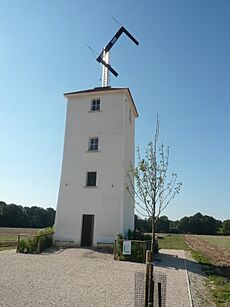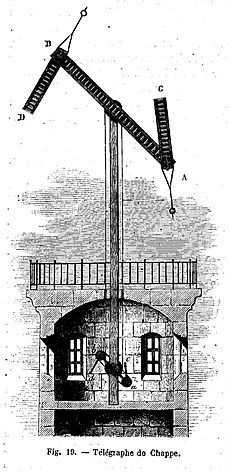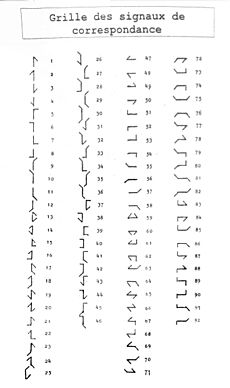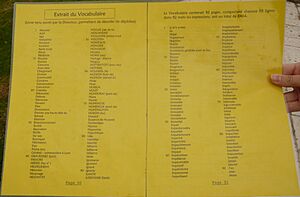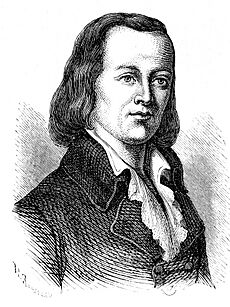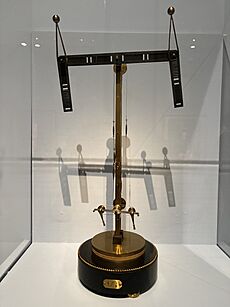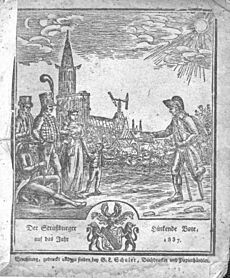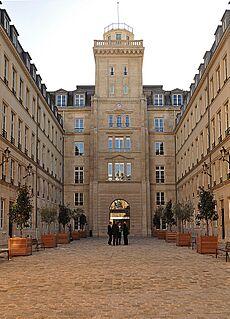Chappe telegraph facts for kids
The Chappe telegraph was an amazing French communication system. It was invented by Claude Chappe in the early 1790s. This system used visual signals, like a giant flag language, to send messages over long distances.
Imagine a chain of towers, each 5 to 15 kilometers apart. People called operators stood in these towers. They used special telescopes to see signals from one tower and then repeat them to the next. This way, messages traveled quickly across the country.
By the mid-1800s, the Chappe telegraph network was huge. It connected many big cities in France and even reached places like Venice, Mainz, and Amsterdam. However, when the electric telegraph came along, it was even faster. So, the Chappe system was eventually taken down. Today, you can still find about twenty of these old Chappe towers, some of them restored.
Contents
How Did the Chappe Telegraph Work?
The Chappe telegraph system changed a bit over time. Engineers made improvements as they learned more about how to make it work best.
The Telegraph Towers
Each Chappe tower had a special signaling machine on top. This machine could be seen from the next tower using powerful telescopes. Here's what made up the signaling part:
- A tall, 7-meter mast, usually sky blue. It had a ladder for workers to reach the moving parts.
- A main black arm called the "regulator." It was about 4.6 meters long.
- Two smaller, rotating black arms called "indicators." Each was about 2 meters long.
- Counterweights, which helped the indicators move smoothly.
- Inside the tower, an operator used a "manipulator." This was a system of cables and pulleys. It let the operator move the large arms on top of the tower. A small model showed the operator exactly what the big arms were doing.
Powerful Telescopes
Every tower had two telescopes. One looked at the tower before it, and the other looked at the tower after it. These telescopes were very strong, magnifying things 30 to 65 times! They were fixed in place, always pointing at the next tower. This meant operators didn't have to adjust them every time a message came through.
Sending Secret Messages
The Chappe telegraph used a clever code. The main arm (regulator) could be in two positions: horizontal or vertical. Each of the two smaller arms (indicators) could be in seven different positions. This meant there were 98 possible arm combinations!
Some of these combinations were for special messages, like "end of message" or "error." This left 92 combinations for actual words. Each of these 92 signals had a number.
To send a message, operators used a special code book. This book had 92 pages, and each page had 92 words or phrases. So, there were 8,464 possible words or phrases they could send!
To send a word, they would send two signals. The first signal told the receiving tower which page number to look at in their code book. The second signal told them which word on that page to choose. For example, if "ignorance" was on page 50, position 87, they would send the signals for (50, 87). This made sure messages were clear and secret.
The Story of the Chappe Telegraph
Why Was It Invented?
Throughout history, sending messages quickly over long distances was a big challenge. This was especially true in France during the French Revolution. At that time, France was facing challenges from other nations. Having a fast and reliable way to communicate would give France a huge advantage.
The Chappe telegraph was the perfect solution! Imagine, a message that took 4 days to travel from Strasbourg to Paris by horse could be sent in just 2 hours with the Chappe system.
Work on this amazing system started in the early 1790s and grew very quickly. It was used for many years. However, its use began to fade when the first electric telegraph line, using Morse code, appeared in 1845. The very last Chappe telegraph message was sent in 1854.
How It Was Invented
In 1791, Claude Chappe had a brilliant idea. He wanted to create a system that would let the government send messages very quickly over long distances. He tried different ways, using both sight and sound. Finally, he decided that visual signals, like a semaphore system, would work best. He realized that the angles of the moving arms were easiest to see clearly from far away.
Chappe did his first tests in March 1791, using synchronized pendulums and panels. He even sent a message: "The National Assembly will reward experiences that are useful to the public."
He moved to Paris and continued his experiments. Chappe and his friends worked hard to get support from the government. They explained how his invention could help France. He said it was "a reliable means of establishing a correspondence." This meant leaders could send orders to the country's borders and get answers back quickly.
In July 1793, a big test was successful, sending messages over 26 kilometers near Paris. Soon after, Chappe was officially named a telegraph engineer. The government then approved building the first major telegraph line, connecting Paris and Lille. Chappe believed his telegraph would help unite France by making distances feel shorter.
Building the Network
The first Chappe telegraph line connected Paris and Lille, a distance of 230 kilometers. This line was mainly for military use. Its fifteen towers could send a short message between the two cities in just 9 minutes!
Over time, the network grew to include many other major French cities, with Paris as the main hub. For example, 58 stations connected Paris to Brest. By 1844, there were 534 towers across France, linking 29 important cities and covering over 5,000 kilometers.
The network also spread to other parts of Europe, reaching Amsterdam, Mainz, and Venice. It even extended to North Africa, with lines built in Algiers and Tunis.
Who Ran the System?
At first, Claude Chappe and his brothers managed the entire system. Later, a more formal government system took over.
Directors were in charge of coding, decoding, and sending messages. Inspectors watched over groups of about ten towers. They made sure equipment worked and checked on the operators.
The tower operators were the most important people in the system. They read signals from one tower and then used the manipulator to send them to the next. Operators did not have the code books, so they couldn't read the messages themselves. They worked every day and had to be very careful not to make mistakes.
How Was It Used?
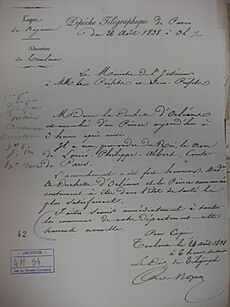
The Chappe telegraph was very effective at sending news quickly across France. For example, it reported military victories in 1794 within minutes of them happening.
Some business people also tried to use the telegraph for their own benefit. In the 1830s, two businessmen tried to get stock market information faster than others. They faced consequences for their actions, as it was seen as an unfair use of the system. This showed how valuable fast communication had become.
See also
- Optical communication


